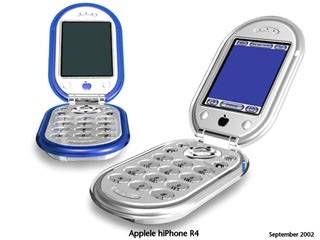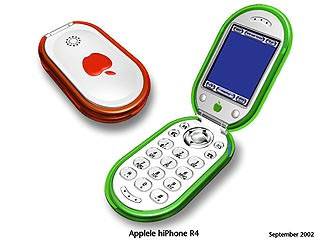 |
||
|
||
| ||
International EUV Symposium: CaFl is still more expensive than gold Photos of Apple Mac smartphones? Intel to reduce Pentium4 and Pentium4-M price difference to 15% Microprocessor Forum 2002: details about VIA Nehemiah and offspring APAC IDF Fall 2002: Intel announces Manitoba ABIT announces SI-1N/SI-1Na server mobos International EUV Symposium: CaFl is still more expensive than gold In his speech Peter Silverman, Intel´s director of lithography capital equipment and one of the members of International EUV Symposium, shared his thoughts about EUV tools implementation prospects.
Source: EE Times
Photos of Apple Mac smartphones? The Chinese site, that posted these photos, is sure these are photos of Apple PDA Phones / Smartphones. Though you can see they are marked "Applele"...I guess it would be bad, if that´s a fake. Such stylish devices are quite worthy of bearing the famous brand.
     Intel to reduce Pentium4 and Pentium4-M price difference to 15% According to messages from Taiwan, Intel is to reduce the price difference between equivalent desktop and mobile Pentium 4 to 10-15%. And current values are:
It´s not a secret that today´s price difference between ò4 and ò4-í resulted in the appearance of desktop CPU notebooks. The new Intel pricing is to sell P4-M stocks to prepare for the new Banias mobile platform. The new pricing is still unavailable. Source: The DigiTimes
Microprocessor Forum 2002: details about VIA Nehemiah and offspring At Microprocessor Forum (MPF) 2002 representatives of Centaur Technology, a part of VIA Technologies, reported more details about company processor roadmaps. They´ve actually provided technological details about Nehemiah (C5XL) processor core, which 1GHz samples are expected later this year. In 2003 VIA plans to raise chip clock to 1.4-1.5 GHz. At Microprocessor Forum the company demonstrated a working platform on VIA CLE266 and 1.13 GHz C5XL processor.
 Details about further processor line development were provided as well. Now in the end of 2003 / beginning of 2004 the company plans to release C5Z core, a higher performance version of C5X, featuring about 2GHz clocks, 22-stage pipeline, SSE2 support, 80 sq.mm crystal, 0.13-micron process. For the low-end market the company plans to release low-power C5XP core and also C5Y with a new high-performance bus. Integrated C5XL and C5Z are planned to 2004, and further plans indicate a mysterious CN chip (perhaps, "N" is a place for another digit) with a completely new architecture. The new Nehemiah (C5XL) core is not something ultranew, featuring architecture already known by C3 (C5N and Ezra-T). Still the core has changed significantly: 17 pipeline stages instead of 12, SSE support, x87 floating point block, operating at full clock. In other wors, the same architecture, but honed and shaped up. According to company representatives, C5XL core will contain 32% more transistors then the current C5N, however, the crystal size is reduced from 56 to 52 sq.mm. VIA plans to leave the cost price at the same level, if not to reduce it as well.
APAC IDF Fall 2002: Intel announces Manitoba At Asia-Pacific Intel Developer Forum (APAC IDF) Fall 2002, that took place on October 14-15 in Taipei, Intel announced new Manitoba mobile processor, combining Xscale core, digital signal processor, and flash memory.Commercialization is expected next year. Supposedly, Manitoba will debut in new 2.5G GSM/GPRS phones. According to the company, Manitoba processors are currently made using 0.13-micron process, however already in 2003 the production will be moved to 0.09-micron process. On the photo: Ron Smith, senior vice president and general manager of Intel´s wireless computing and communications group, holding an 8-inch wafer of Manitoba chips.
 Source: The DigiTimes
ABIT announces SI-1N/SI-1Na server mobos ABIT Computer announced two new system boards for 1U rackmount servers: SI-1N and SI-1Na. Both base on Intel 845GL chipset and supprot Socket 478 Intel Pentium 4 with 512KB L2 cache and 400 MHz FSB.  SI-1N features Micro ATX design and has 2 DIMM sockets (up to 2GB low-profile non-ECC un-buffered DDR200/266), one 32-bit 33 MHz PCI slot, 4-channel Ultra DMA/ATA133 RAID (HighPoint HPT374, RAID 0,1,0+1), Gigabit LAN (Broadcom BCM5702), 2 USB ports. SI-1Na differs by two 10/100Base-T LAN (2xIntel 82550EY) instead of Gigabit LAN and doesn´t have IDE RAID.
Write a comment below. No registration needed!
|
Platform · Video · Multimedia · Mobile · Other || About us & Privacy policy · Twitter · Facebook Copyright © Byrds Research & Publishing, Ltd., 1997–2011. All rights reserved. | ||||||||||||||||||||||||||||||||||||||||||||||||||||||||||||||||||||||||||||||||||||||||||||||||||||||||||